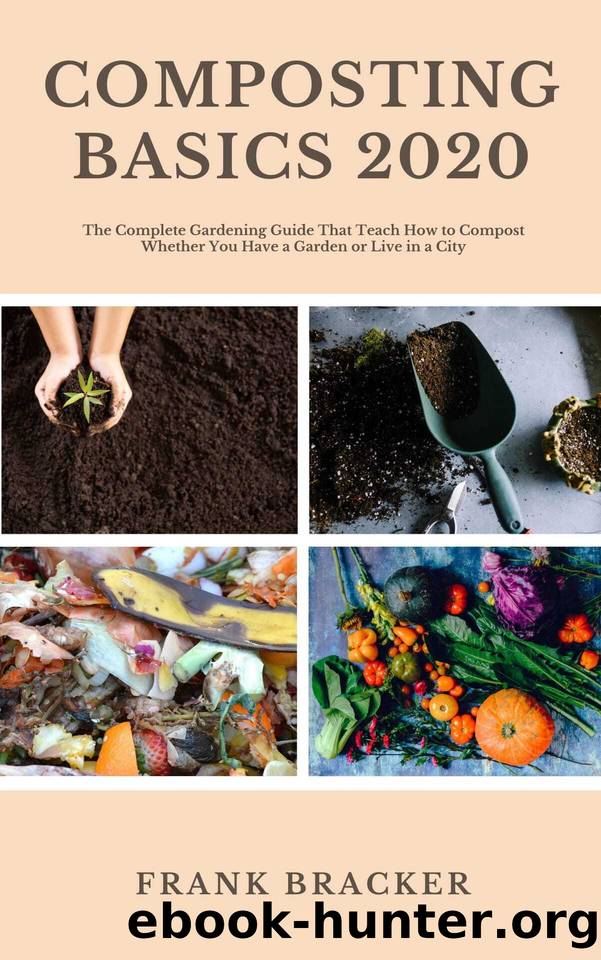Composting Basics 2020: The Complete Gardening Guide That Teach How to Compost Whether You Have a Garden or Live in a City by Frank Bracker

Author:Frank Bracker [Bracker, Frank]
Language: eng
Format: azw3
Published: 2020-05-01T16:00:00+00:00
Chapter 6: Selecting Your Ingredients
All of the once-living things decompose finally, which means you could wonder if it matters what enters your mulch pile or just how much material you're using. If you are in no rush to acquire usable compost, then you do not need to be overly worried about those problems -- mulch occurs. But if you are a gardener who needs a great deal of crumbly compost earlier instead of later, knowing the fundamental hows and whys of choosing carbon-rich and nitrogen-rich natural things and combining them in the ideal percentage is valuable.
This chapter identifies the distinct organic substances accessible to place in your compost heap and enables you to find out the most effective proportions of every Additionally, and it covers all of the stuff which should certainly stick out from the heap! At length, tons of thoughts on locating free components (and keeping them) render you no explanations for exercising the nuclear issue!
Getting rid with Browns: Carbon-Rich Ingredients
Gardeners who Materials often reference carbon-rich substances as browns because nearly all of them are a variety of shades of brown. Sugar precious carbon substances offer energy for germs whenever they busily break your fundamental issue. Carbons for its compost heap (as a way of overall accessibility for the majority of people ) contain tender leaves, woody plant trimmings, all kinds of paper goods, walnut, pine needles, and sawdust.
Dry leaves
Dry leaves are most likely the simplest brownish ingredient to utilize to get a start composter since they are already small parts of organic matter, which are simple to shred into tinier pieces should you select. They are also in plentiful supply in many areas and become quite adequate completed compost (known as leaf mold) all independently, with no inclusion of different substances. Just have a peek at some woodland floor to realize how it occurs. The local faucet" When life provides you leaves, create leaf mold" informs you how you can work with plenty of leaves to make moisture-enhancing compost.
Shredding leaves reduces their quantity, which makes it less challenging to stockpile considerable quantities to add to your mulch as required. Shred leaves by dispersing them throughout the grass and running them over using a lawnmower. No mower and lawn? Fill out plastic trash can half filled with leaves and then put a weed eater inside like a leaf shredder. (make sure you use protective eye equipment.)
Woody plant trimmings
Shrubs, trees, palms fronds, dead perennial stalks, Brussels sprout stalks, and dried cornstalks all fit into such a group. Split, chop and then scatter the substance as far as you can to accelerate decomposition. (Chapter 2 explains tools that assist for this.) But if you can not embarrass it little, do not worry; there is nothing wrong with yanking partly decomposed branches and twigs out of a completed compost pile to improve some other heap (maybe multiple times) till they are totally"gone" Another usage for woody substances: Distribute them in the base of a heap before building to market aeration.
Get some of your neighbors together and organize to handle your pruning tasks at precisely the same moment.
Download
This site does not store any files on its server. We only index and link to content provided by other sites. Please contact the content providers to delete copyright contents if any and email us, we'll remove relevant links or contents immediately.
| Colder Climates | Desert |
| Temperate | Tropical |
Turbulence by E. J. Noyes(7032)
The Thirst by Nesbo Jo(5778)
Gerald's Game by Stephen King(3913)
Be in a Treehouse by Pete Nelson(3206)
Marijuana Grower's Handbook by Ed Rosenthal(3114)
The Sprouting Book by Ann Wigmore(3049)
The Red Files by Lee Winter(2908)
The Remains of the Day by Kazuo Ishiguro(2614)
Sharp Objects: A Novel by Gillian Flynn(2440)
Christian (The Protectors Book 1) by L. Ann Marie(2393)
Organic Mushroom Farming and Mycoremediation by Tradd Cotter(2304)
The Culinary Herbal by Susan Belsinger(2055)
Stone Building by Kevin Gardner(1992)
The Starter Garden Handbook by Alice Mary Alvrez(1922)
Lilac Girls by Martha Hall Kelly(1868)
The Unlikely Pilgrimage of Harold Fry by Rachel Joyce(1834)
The Lean Farm Guide to Growing Vegetables: More In-Depth Lean Techniques for Efficient Organic Production by Ben Hartman(1782)
Urban Farming by Thomas Fox(1748)
Backyard Woodland by Josh VanBrakle(1586)
